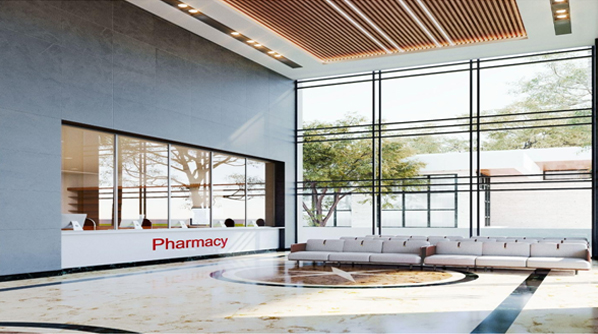
The Influence of Colour in Healthcare Facility
In the world of healthcare facility design, every element plays a crucial role in fostering an environment conducive to healing and well-being. Among these elements, colour stands out as a powerful tool that can significantly influence patients, visitors, and healthcare professionals alike. From calming blues to energising yellows, the palette chosen for hospital interiors can have a profound impact on mood, perception, and overall experience.
Explore how the strategic use of colour can positively influence the ambiance and functionality of healthcare spaces, and how Renascent Consultants keep the standards in mind.
Explore how the strategic use of colour can positively influence the ambiance and functionality of healthcare spaces, and how Renascent Consultants keep the standards in mind.
1. Promoting Healing and Relaxation :
When patients enter a healthcare facility, they often experience stress and anxiety. Thoughtfully selected colours can help alleviate these feelings by promoting a sense of calm and relaxation. Soft, muted tones such as pastel blues, greens, and lavenders are known for their soothing effects, helping to create a serene atmosphere conducive to healing. These colours can be incorporated into patient rooms, waiting areas, and corridors to promote a sense of tranquillity.
Anchal Hospital, designed by Renascent Consultants, has a lot of pastel shades in the interior. This is because we focus on promoting healing and relaxation in the healthcare sector. We strongly feel that pastels can give a sense of relaxation to the patients and help in quicker healing.
Anchal Hospital, designed by Renascent Consultants, has a lot of pastel shades in the interior. This is because we focus on promoting healing and relaxation in the healthcare sector. We strongly feel that pastels can give a sense of relaxation to the patients and help in quicker healing.
2. Enhancing Comfort and Safety :
In healthcare environments, it is essential to create spaces that feel safe and comfortable for patients and staff alike. Warm, inviting colours such as earthy tones and soft neutrals can evoke a sense of security and familiarity. These hues can be used in areas like reception desks, nursing stations, and staff break rooms to enhance comfort and promote a welcoming atmosphere. Additionally, contrasting colours can be strategically employed to highlight important signage and wayfinding elements, aiding in navigation and promoting patient safety.
3. Boosting Mood and Morale :
Hospitals can be emotionally challenging environments for both patients and healthcare professionals. Bright, cheerful colours such as yellows, oranges, and greens can help uplift spirits and boost morale. These vibrant hues can be incorporated into common areas like cafeterias, rehabilitation spaces, and staff lounges to create a positive and energising atmosphere. By infusing spaces with lively colours, healthcare facilities can contribute to a more optimistic outlook for all who enter.
4. Supporting Cognitive Function :
The choice of colour in healthcare design is not solely about aesthetics but also has implications for cognitive function and productivity. Research suggests that certain colours can stimulate brain activity and improve focus and concentration. For example, cool tones like blues and greens have been shown to enhance cognitive performance and promote a sense of clarity and concentration. These colours can be integrated into spaces such as consultation rooms, offices, and conference areas to support optimal cognitive function among healthcare professionals.
Bakul Chandra, a Co-founder and Mentor at Renascent Consultants, highlights the guiding principles behind the conceptualisation of PSM Hospital in Haldwani. This facility has been meticulously designed to cater to various requirements, optimising space, natural light, greenery, and sustainability, all while keeping cool tones in mind.
Bakul Chandra, a Co-founder and Mentor at Renascent Consultants, highlights the guiding principles behind the conceptualisation of PSM Hospital in Haldwani. This facility has been meticulously designed to cater to various requirements, optimising space, natural light, greenery, and sustainability, all while keeping cool tones in mind.

5. Cultural Sensitivity and Individual Preferences :
It is essential for healthcare facilities to consider cultural sensitivities and individual preferences when selecting colour palettes. Different cultures may have varying associations with colours, and patients may have personal preferences or sensitivities that should be taken into account. Offering a diverse range of colour options and incorporating elements of cultural significance can ensure that healthcare environments are inclusive and accommodating to all.
6. Wayfinding and Orientation :
Navigating through a large healthcare facility can be overwhelming, especially for patients and visitors who may be unfamiliar with the layout. Colour can serve as a powerful tool for wayfinding and orientation. By assigning specific colours to different departments or areas, such as blue for emergency services or green for outpatient clinics, patients can easily identify where they need to go. This reduces confusion and enhances the overall experience of navigating the healthcare environment.
Take Away
We, at Renascent Consultants understand that the influence of colour in healthcare facilities cannot be overstated. From promoting relaxation and comfort to enhancing productivity and wayfinding, colour can play a multifaceted role in shaping the patient experience and facilitating healing. By understanding the psychological effects of colour and incorporating thoughtful design principles, healthcare facilities can create environments that support the well-being of patients, staff, and visitors alike. Ultimately, harnessing the power of colour is not just about aesthetics, it is about creating spaces that foster healing, hope, and compassion.
